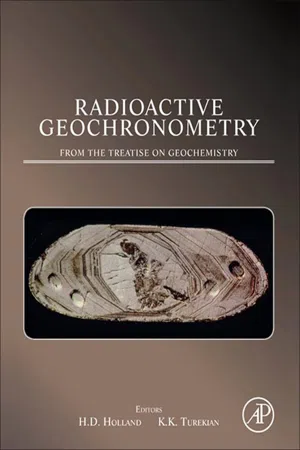
Radioactive Geochronometry
A derivative of the Treatise on Geochemistry
- 544 pages
- English
- ePUB (mobile friendly)
- Available on iOS & Android
Radioactive Geochronometry
A derivative of the Treatise on Geochemistry
About This Book
The history of Earth in the Solar System has been unraveled using natural radioactivity. The sources of this radioactivity are the original creation of the elements and the subsequent bombardment of objects, including Earth, in the Solar System by cosmic rays. Both radioactive and radiogenic nuclides are harnessed to arrive at ages of various events and processes on Earth.
This collection of chapters from the Treatise on Geochemistry displays the range of radioactive geochronometric studies that have been addressed by researchers in various fields of Earth science. These range from the age of Earth and the Solar System to the dating of the history of Earth that assists us in defining the major events in Earth history. In addition, the use of radioactive geochronometry in describing rates of Earth surface processes, including the climate history recorded in ocean sediments and the patterns of circulation of the fluid Earth, has extended the range of utility of radioactive isotopes as chronometric and tracer tools.
- Comprehensive, interdisciplinary and authoritative content selected by leading subject experts
- Robust illustrations, figures and tables
- Affordably priced sampling of content from the full Treatise on Geochemistry
Frequently asked questions
Information
Cosmic-Ray Exposure Ages of Meteorites
1.1 INTRODUCTION
| Nuclide | Half-lifea (Myr) |
| Radionuclides | |
| 14C | 0.005730 |
| 59Ni | 0.076 |
| 41Ca | 0.1034 |
| 81Kr | 0.229 |
| 36Cl | 0.301 |
| 26Al | 0.717 |
| 10Be | 1.51 |
| 53Mn | 3.74 |
| 129I | 15.7 |
| Stable nuclides | |
| 3He | |
| 21Ne | |
| 38Ar | |
| 83Kr | |
| 126Xe |
Table of contents
- Cover image
- Title page
- Table of Contents
- Copyright page
- Introduction
- Contributors
- 1: Cosmic-Ray Exposure Ages of Meteorites
- 2: Early Solar System Chronology
- 3: The Origin and Earliest History of the Earth
- 4: Long-Lived Chronometers
- 5: The Geochemistry and Cosmochemistry of Impacts
- 6: Geochronology and Thermochronology in Orogenic Systems
- 7: Ages and Growth of the Continental Crust from Radiogenic Isotopes
- 8: Radiocarbon
- 9: Natural Radionuclides in the Atmosphere
- 10: Groundwater Dating and Residence-time Measurements
- 11: Cosmogenic Nuclides in Weathering and Erosion
- 12: Geochronometry of Marine Deposits
- 13: Chronometry of Sediments and Sedimentary Rocks
- 14: The Early History of Life
- 15: Heavy Metals in the Environment—Historical Trends
- APPENDIX 1: Periodic Table of the Elements
- APPENDIX 2: Table of Isotopesa
- APPENDIX 3: The Geologic Timescale
- APPENDIX 4: Useful Values
- Index